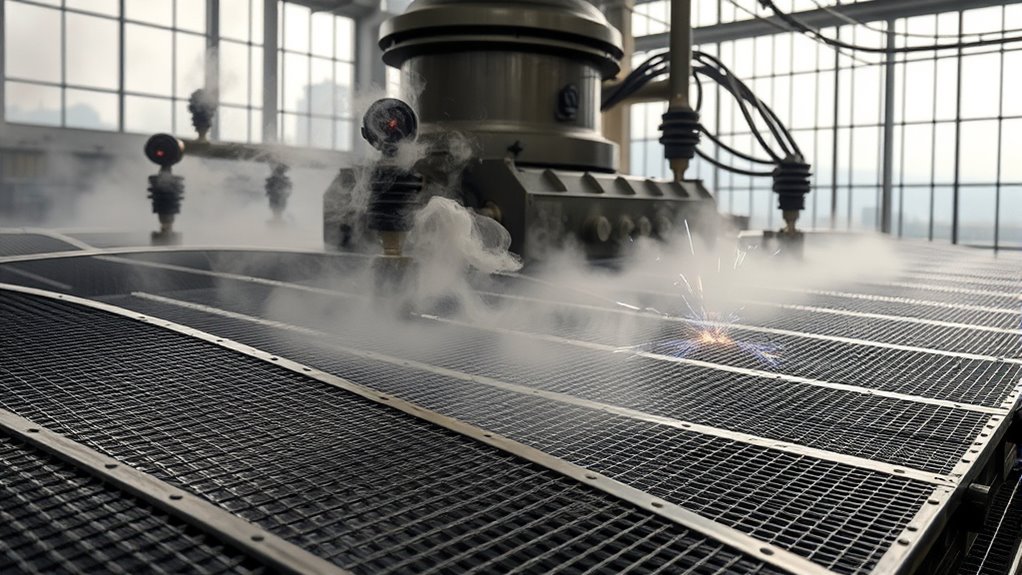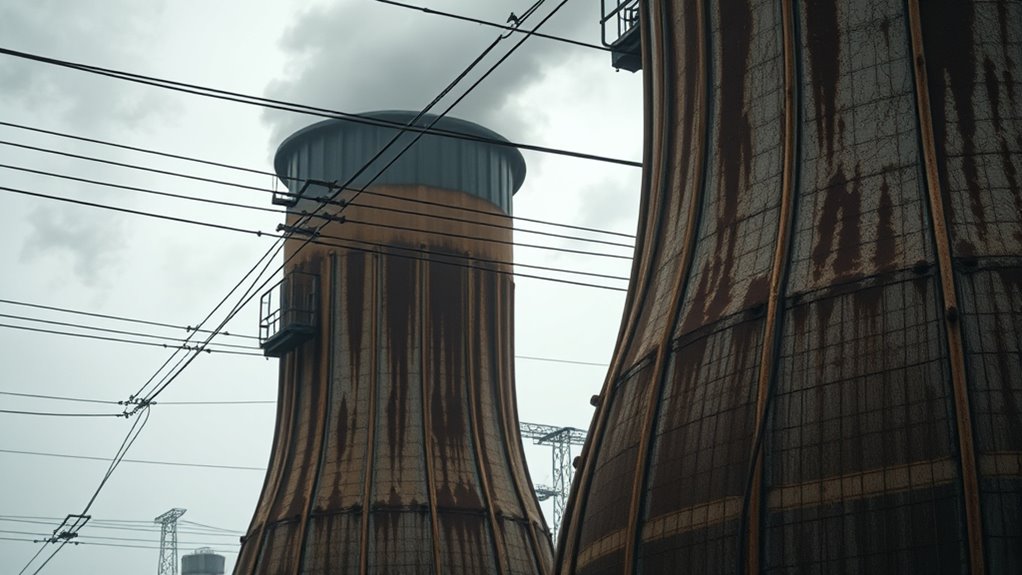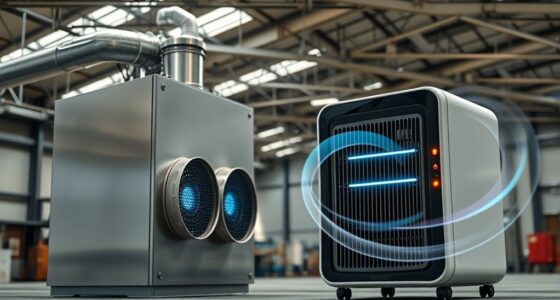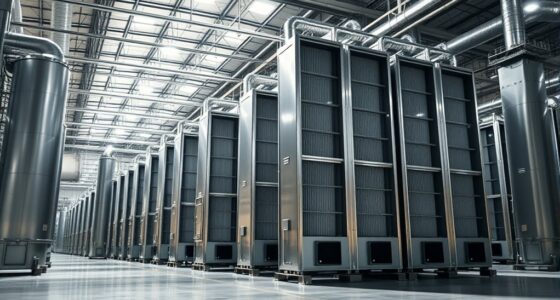Electrostatic precipitators, once seen as outdated, are making a strong comeback due to recent technological advances that boost their efficiency and reduce costs. These devices use electric charges to remove fine particles from industrial exhaust gases, helping industries meet stricter emission standards and lower pollution. They produce minimal waste and can be powered by renewable energy sources. If you want to learn how these innovations are transforming air pollution control, there’s more to discover ahead.
Key Takeaways
- Modern advancements have revitalized electrostatic precipitators, improving efficiency and cost-effectiveness.
- Their ability to effectively capture fine particles makes them increasingly popular in pollution control.
- Enhanced technology allows integration with renewable energy sources, reducing overall environmental impact.
- Stricter environmental regulations drive industries to adopt or upgrade electrostatic precipitators.
- Ongoing innovations, including AI monitoring, are making old tech more adaptable and reliable for modern needs.

Electrostatic precipitators are devices that remove fine particles from exhaust gases in industrial processes, helping reduce air pollution. If you’re concerned about air quality and the environmental impact of industrial emissions, you’ll appreciate how these systems contribute to effective pollution control. They play a crucial role in cleaning up the air by capturing dust, smoke, and other particulate matter before they escape into the atmosphere. This not only helps industries meet regulatory standards but also benefits communities nearby by lowering exposure to harmful pollutants.
Electrostatic precipitators effectively capture airborne particles, reducing industrial emissions and promoting cleaner air for communities.
You might be surprised to learn that electrostatic precipitators have been around for over a century, yet they are experiencing a resurgence. Modern advancements have improved their efficiency, making them more cost-effective and adaptable to different industrial settings. This old technology is making a comeback because of the increasing emphasis on cleaner production methods and stricter environmental laws. As industries seek sustainable solutions, electrostatic precipitators offer a reliable way to control pollution without the need for extensive chemical treatments or filters that wear out quickly.
When operating an electrostatic precipitator, you’ll notice how it uses electric charges to trap particles. Exhaust gases pass through a chamber where high-voltage electrodes impart a charge to airborne particles. These charged particles then migrate toward oppositely charged collection plates, where they settle out of the gas stream. This process is highly efficient, especially for fine particulate matter that traditional filters might miss. Because they can process large volumes of gases continuously, electrostatic precipitators are ideal for power plants, cement factories, and other heavy industries aiming to improve air quality.
One of the key reasons they’re making a comeback is because of their lower operational costs and environmental benefits. Unlike some pollution control methods that rely heavily on filters or chemicals, electrostatic precipitators use electricity, which can be generated from renewable sources. Plus, they produce minimal waste—mainly the collected ash or dust—which can often be recycled or disposed of safely. This aligns with global efforts to reduce the carbon footprint of industrial processes while maintaining high standards of pollution control.
In essence, if you’re involved in managing industrial emissions or advocating for cleaner air, understanding electrostatic precipitators can help you implement effective pollution control strategies. They’re a proven technology that, with modern enhancements, continue to be relevant in the push toward better air quality worldwide. As regulations tighten and public awareness grows, these age-old devices are proving that sometimes, the best solutions are those that stand the test of time—refined and ready to meet today’s environmental challenges. Additionally, ongoing research into AI security and monitoring can further optimize their operation for maximum efficiency and safety.
Frequently Asked Questions
How Do Electrostatic Precipitators Compare to Modern Air Filtration Systems?
You might wonder how electrostatic precipitators compare to modern air filtration systems. They excel in improving air quality by capturing fine particles efficiently, often with lower energy consumption than some newer options. While HEPA filters can provide superior particle removal, precipitators are more cost-effective for large-scale industrial use. Overall, electrostatic precipitators remain a viable, energy-efficient choice, especially when balancing air quality improvement and operational costs.
What Are the Maintenance Costs Associated With Electrostatic Precipitators?
You wonder about the maintenance costs of electrostatic precipitators, and the answer isn’t straightforward. With careful cost estimation, you’ll find that maintenance frequency varies depending on usage and environment. Regular inspections and cleaning are essential, but costs can add up over time. Yet, their efficiency could save you money in the long run, making the investment worthwhile. Stay vigilant, and you’ll manage expenses while reaping the benefits of this proven technology.
Can Electrostatic Precipitators Remove Gases or Only Particulate Matter?
You might wonder if electrostatic precipitators can remove gases or only particulate matter. They mainly target particles, improving air quality and supporting emission control. While they excel at capturing dust, smoke, and aerosols, they don’t effectively eliminate gases. For thorough emission control, you often need additional systems like scrubbers or catalytic converters to handle gaseous pollutants alongside electrostatic precipitators, ensuring cleaner air.
Are Electrostatic Precipitators Effective for All Types of Industrial Emissions?
You might think electrostatic precipitators work universally, but their effectiveness varies with emission types. While they’re great at capturing particulate matter, industrial limitations mean they may struggle with gases or complex emissions. For certain emission types, like fine or sticky particles, they perform well. However, for others, like gases or very fine aerosols, you might need additional control devices. So, their effectiveness depends on the specific industrial limitations and emission types involved.
What Advancements Are Being Made to Improve Electrostatic Precipitator Efficiency?
You’re curious about how advancements improve electrostatic precipitator efficiency. Researchers are focusing on electrode enhancement to increase collection efficiency and reduce energy use. Corona technology has advanced, creating more uniform ionization and better particle capture. These improvements mean your system can handle diverse emissions more effectively, making electrostatic precipitators more reliable and environmentally friendly. With ongoing innovations, these old systems are becoming smarter and more efficient than ever before.
Conclusion
So, seize the chance to see electrostatic precipitators revitalize our air quality. Their timeless tech towers as a testament to tried-and-true solutions, transforming pollution into purity. By embracing this ancient approach with a modern mindset, you can champion cleaner, clearer skies. Remember, recycling reliable methods isn’t just smart—it’s essential. Stay steadfast, support sustainable strategies, and see how old tech can turn today’s troubles into tomorrow’s triumphs!









